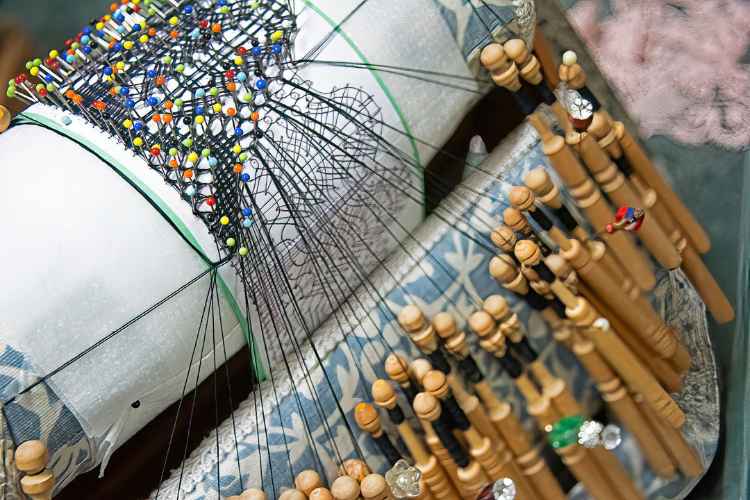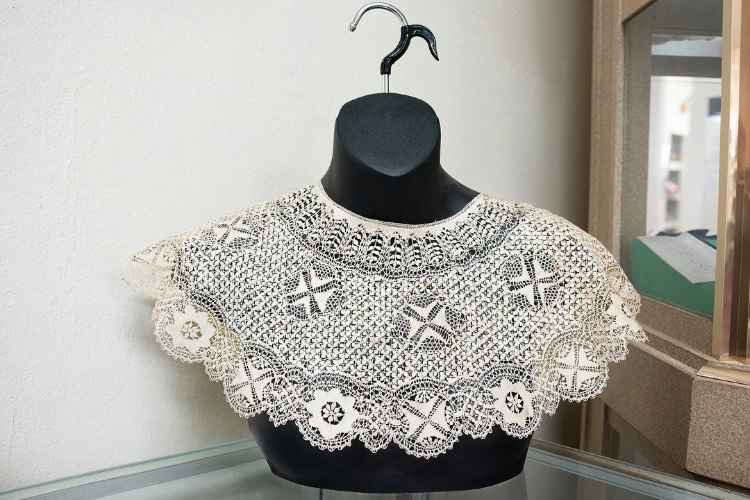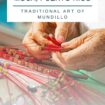
We are reader-supported and may earn a commission on purchases made through links in this article.
Lilliam Cordero Torresola’s fingers are a blur as she deftly twists and twirls the dozens of pairs of wooden spindles she’s using to make mundillo, the traditional lace of Puerto Rico. The long ribbon of scalloped trim, crafted of fine pale pink thread and showcasing a cluny-style web of open weave and tight details, is slow to take form.
One inch can take hours to produce. Even if Cordero works for extended periods each day, depending on the desired length, the lace will take her weeks, if not months, to complete.
Cordero has been making mundillo for more than 60 years. On this day, she joins five other women for an afternoon of lacemaking at the Museo del Mundillo in Moca, a small town on the northwest corner of the island. Known as “La Capital del Mundillo,” Moca is famous for its bobbin lace, which has been produced by women of the town for hundreds of years.
Making Mundillo

As the name suggests, bobbin lace uses bobbins instead of needles to manipulate the thread. The art form dates to the 1500s in Europe. Some well-known kinds of bobbin lace include Chantilly from France, point de Flandres from Belgium, and Madeira from Spain. Each has its own techniques and motifs.
Mundillo, an intricate lace that looks like fine crochet, often features detailed designs rendered in white or cream thread and is similar to England’s Honiton lace, which was favored by Queen Victoria.
Best Tips & Tools to Plan Your Trip
It decorates clothing, household linens, and all things baby. “When our babies leave the hospital, it’s always in a dress with mundillo,” says Johanna Rocio del Mar Flores Perez, president and founder of Ruta Artisanal Boricua, a tour company that specializes in Puerto Rico’s artisan heritage.
The lace takes its name from the mundillo, a rotating bolster-shaped pillow set into a wood frame known as a telar. The apparatus rests on a tabletop or in the artist’s lap. The pattern, a technical drawing of lines and dots sketched out on paper or cardstock, is held in place on the pillow by pins, which also are used to guide the threads as they are braided, twisted and knotted to form the design.
The thread is spooled around the neck of the bobbins, or bolillos, wooden dowels about 5-6 inches long and the diameter of a pencil.
A Centuries-Old Tradition

According to Benito “Mokay” Hernandez Vale, founder of the Museo del Mundillo, the tradition of making lace in Puerto Rico using the mundillo and telar began in the mid-1800s. While the exact origins are a bit hazy, it is believed that a Spanish woman, most likely from the Canary Islands, came to Moca and began teaching bobbin lacemaking to the women in her neighborhood.
“That’s how we got one block that we call the block of the bobbin lace,” Hernandez explains. “Since then, people started calling us the capital of the bobbin lace in Puerto Rico, because we were the only place on the island that was doing lace for many years.”
Hernandez opened his museum in 2005. “My mother was a lacemaker, and I have three sisters who do lace,” he says. “After my mother passed away, I started thinking about creating a museum to save this history and legacy of mundillo lace.”
Housed in a yellow and red 1935 former health clinic, the museum is located about one block from Moca’s central Plaza José D. Quiñones. Inside, tiny rooms are jam-packed with tablecloths, napkins, and pillowcases; a collection of telars, mundillos, and bobbins in various sizes; patterns drawn on a variety of materials; lacemaking supplies available for purchase; and clothing, from vintage wedding dresses in glass cases to baptism gowns and men’s guayaberas.
On one wall, a display illustrates the differences in lace samples from around the world. On another, a framed oversized lace “map” of Moca’s 12 barrios is displayed.
Cultural Appeal

As I enter the museum, the staccato click-clacking of wooden bobbins greets me. It is soothing, like a gentle rain on bamboo chimes. In a back room, Cordero and the other women—mundillistas, as lacemakers are known—sit shoulder-to-shoulder around a small table. They do not speak. Instead, each is focused on a project in front of her.
Maria Cardona has been making mundillo for more than 50 years. She explained the use of the bolillos, which are always worked in pairs. Each strand, each detail, requires a different number of bolillos. Simple pieces can be made with as few as 12 pairs of bobbins; more complex creations can require upwards of 50 or more pairs.
Speaking Spanish, Cardona notes that while the main influence for mundillo patterns comes from Spain, traditional Spanish lace features more geometric motifs. “The difference is the technique. We developed our own technique here,” Cardona says. According to the Institute of Puerto Rican Culture, mundillo patterns were inspired by the island’s natural elements, such as flowers and leaves.
“The work of the mundillo is in the details and the use of the bolillos,” Flores Perez adds. “It is not easy, I’m telling you.”
To the right of Cardona, Carmen Gloria Flores has started weaving a large scalloped Peter Pan-style collar. Instead of the rounded mundillo and telar, she uses a flat pillow — more in line with French techniques — from which hang more bobbins than I can count. Bright red thread is shaped around hundreds of ball-head pins in a rainbow of colors. The collar’s pattern is a delicate open weave interspersed with a classic diamond motif.
For all the women, mundillo is a hobby. For some, their mothers, grandmothers, or sisters made mundillo. Cardona’s mother was a well-known lacemaker in Puerto Rico, and her young niece is interested in learning the skill.
Hernandez adds that men also are taking up the craft. “The couple of men I know who do lace in Moca, let me tell you, they are very good,” he notes. One of the women in the group, Migdalia “Negri” Cordero-Moralez, who has been making lace for eight years, says that she has been teaching her husband to make lace.
Preserving Heritage

Like it did with so many other traditional craft forms, industrialization brought about a cheaper, mass-produced lace, and the art of handmaking bobbin lace declined. However, mundillo remains a viable business in Moca, with many women and men making lace as a full- or part-time job. Although the number of shops devoted to selling lace has decreased in recent years, there are still plenty of markets and studios in town where visitors can purchase lace or watch it being made.
The opening of the museum—and a renewed interest around the world in handmade artisanal crafts—is also breathing new life into mundillo. The museum regularly hosts workshops, classes, and special events for folks of all ages. While there used to be just a few hundred mundillistas in Puerto Rico in the latter half of the 20th century, today, there are thousands of lacemakers on the island.
“People keep on learning, and now we are going to other towns to make (lacemaking) groups. We have 19 different groups around the island,” Hernandez says. “I think we are doing very well to keep alive the original tradition of lacemaking.”
If You Go:

Moca may be off the typical tourist path, but it is less than a half-hour from popular west coast surf towns such as Aguadilla and Rincon. For a full mundillo-themed experience, after a visit to the museum, head over to the main plaza for a peek at the towering Monumento a la Tejedora. The bronze statue of a weaver pays homage to the town’s mundillo artisans.
Afterward, stop by the Mundillo Bar & Restaurant, which opened in 2023. Located just steps from the museum, this bright, airy eatery is dedicated to Moca’s lacemaking heritage. The walls are decorated with vintage photos and stories that tell the history of Moca. Giant bolillos dangle from the ceiling, and a larger-than-life mundillo hangs on the wall near the front entrance. Even the napkin holders are designed to look like miniature mundillos. Try traditional Puerto Rican dishes, such as mofongo, bacalaitos (codfish fritters), and bistec encebollado (steak and onions), and wash it all down with a refreshing craft cocktail, mojito or piña colada.
Inspire your next adventure with our articles below:
Author Bio: Rebecca L. Rhoades is an award-winning writer, editor, and photographer living in Phoenix, Arizona. She specializes in travel, sustainability, design, and culture. Her work has been featured in various print and online publications, including Atlas Obscura, Hotel Scoop, Green Living, Plate, Preferred Travel, AAA magazines, and many more. Follow her adventures on Instagram.
- Which Hawaiian Island is Best to Visit? A Guide to Hawaii - July 14, 2025
- Palawan Perfection: Exploring the Philippines’ Last Ecological Frontier - July 13, 2025
- A Journey to Ashland, Oregon’s Shakespeare Festival - July 13, 2025

